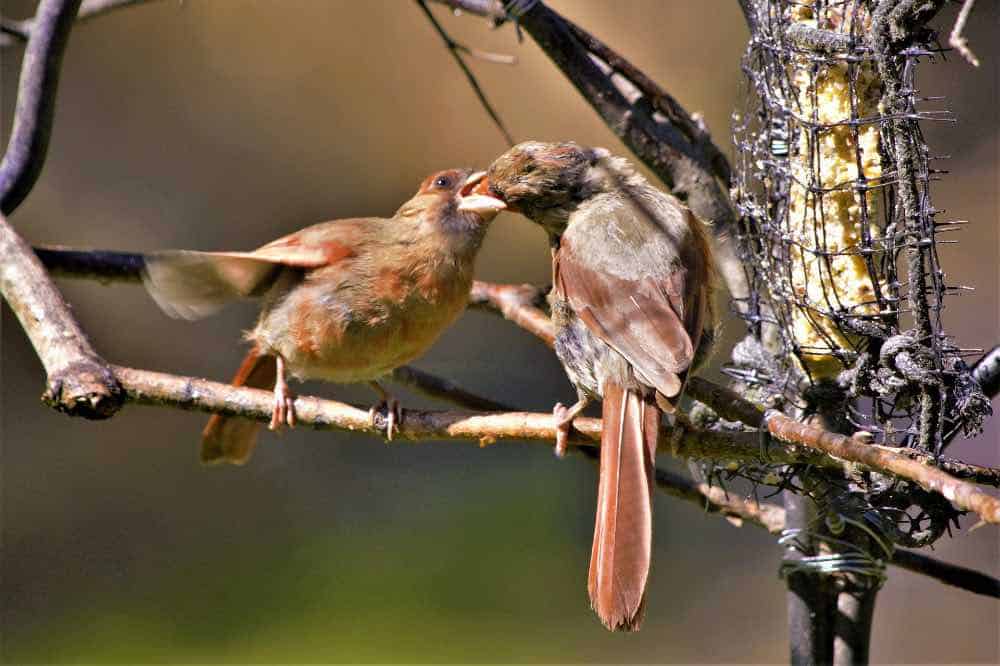Inside: A dedication to the female cardinal and all her family responsibilities + lots of pictures!
After more than 20 years as a backyard birder, I’ve seen my share of female cardinals but never really appreciated her as a mother until recently.
I regularly refer to Gary Ritchison’s book “Wild Bird Guides: Northern Cardinal.” when researching the cardinal species. In doing so, I’ve come to the conclusion that the female cardinal should win the Mother of the Year award. Seriously.
From the beginning to the end of the breeding season, the female cardinal is a wild bird machine! For more than 6 months she tirelessly devotes all of her time and energy to her babies. Sure, the male helps out in a lot of ways, but without her who knows where the cardinal species would be today?
I developed a profound admiration for the female cardinal as a mother and just had to share.
Why the female cardinal is Amazing
The female cardinal is truly amazing. I’d go so far as to say she should be eligible for the Mother of the Year award – particularly during the breeding season. It’s not that the male cardinal doesn’t do anything, it’s that the female cardinal is always doing something and has the primary responsibility for many tasks during the breeding season.
Specifically, here are the 9 reasons the female cardinal should be Mother of the Year:
- Carefully chooses her mate
- Selects the site for the nest
- Builds the nest
- Lays the eggs
- Incubates the eggs
- Primary diaper-changer
- Adopts other birds’ chicks
- Takes care of the young
- Broods the nestlings
Reason #1: The Female Cardinal Has to Carefully choose her mate
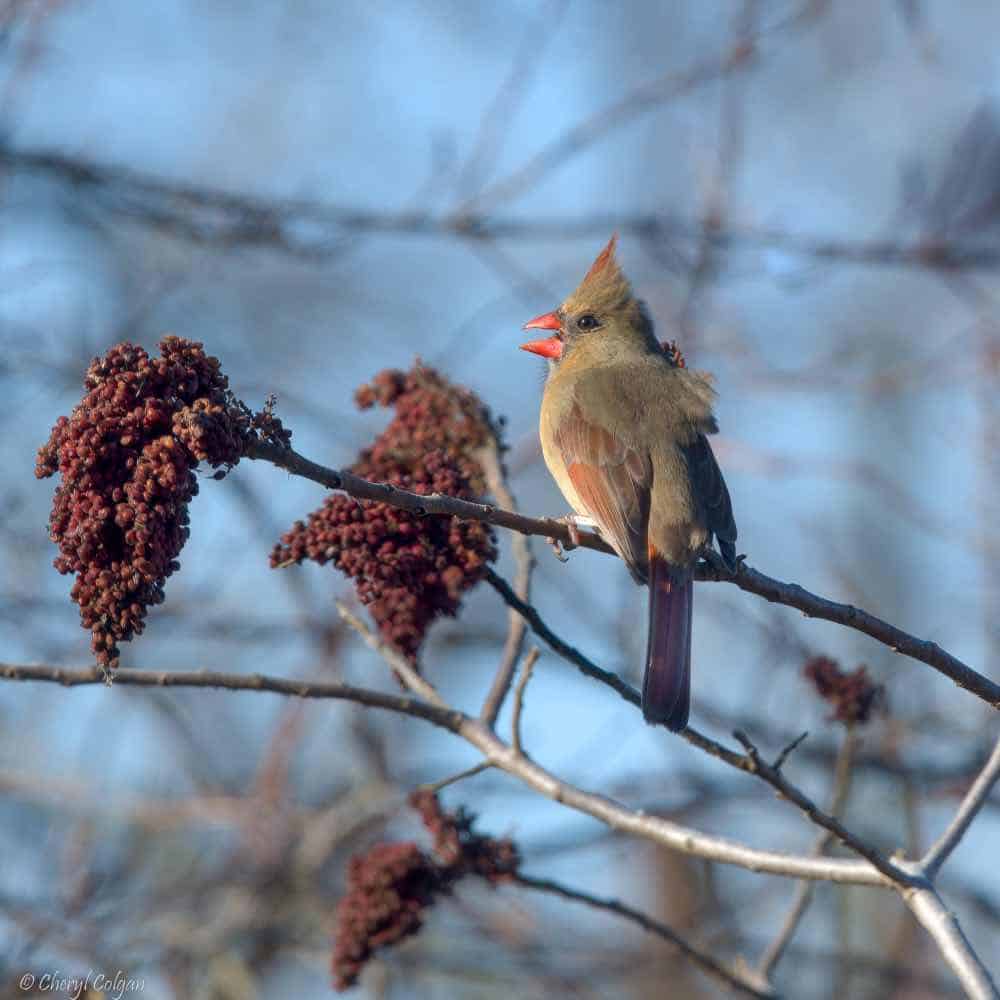
All wild birds have a single goal in mind – to reproduce. Cardinals are no different and it all begins with the female cardinal choosing her mate. Yes, the female cardinal chooses the male cardinal.
And, she doesn’t take this job lightly. After all, the future of her species depends on it.
Selecting the right male cardinal is crucial for breeding. Not only does he need to be healthy and strong to help carry out the breeding tasks, he also must have secured a territory rich in food, water, and shelter. Without these key elements, feeding and protecting the cardinal family is more difficult and less likely to succeed.
The female selects her mate after a period of courting which includes spending time in his territory. She gets a feel for the food and water availability as well as the quality of possible nesting sites within his territory.
The female cardinal requires quality food (wild fruits, insects, spiders), and a lot of it, leads up to egg laying and throughout the breeding season.
The young cardinals are mostly fed insects, especially the nestlings. The territory needs to be able to provide a lot of insects. The babies eat a lot.
One way she can determine if the male cardinal is a worthy mate is through a mating ritual called courtship feeding.
Cardinal birds feed each other as part of the mating ritual called courtship feeding. This practice entails the male cardinal providing and feeding food to the female. The female may assess the worthiness of this potential mate by the quality of the food he brings.
Did you know that one way that female cardinals determine a mate’s worthiness is by how bright red his feathers are?
Reason #2: The Female Cardinal Selects the site for the nest
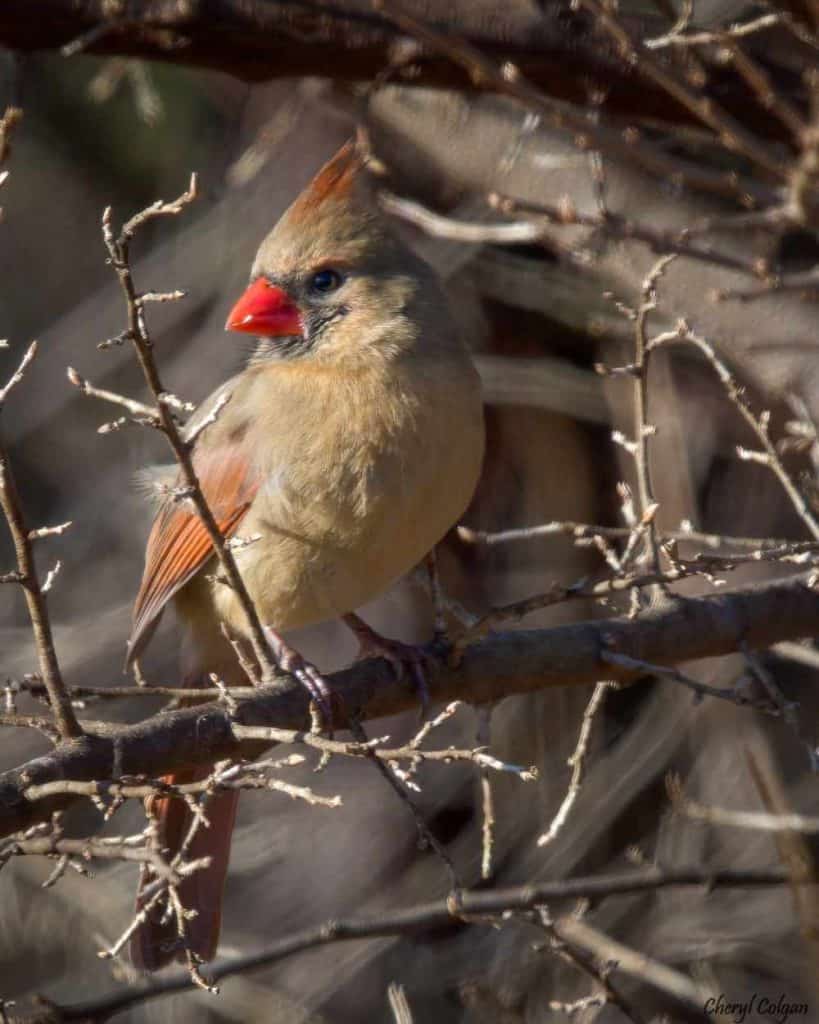
Not only is the female cardinal responsible for scouting out and selecting the nesting site – but she’s also responsible for scouting out and selecting ALL of the nesting sites.
Since cardinal pairs raise anywhere between 1-4 broods in a season and each brood gets its own unique nest, the female puts a lot of time and energy into looking for the ideal location for each brood.
Her primary goal is to find a site that protects the nest from predators.
This usually means locating a shrub or tree with thick branching to conceal the nest and young.
Sounds simple enough but consider this – as the season progresses and vegetation grows in the territory, the ideal site location is often higher.
Reason #3: The Female Cardinal Builds the nest
As if finding a nesting location for each brood wasn’t enough, the female cardinal is also the primary builder of the nest. Again, this means she could be building up to 4 nests in a given season.
If you’re thinking she just plunks down some twigs and grasses and calls it a nest, you’d be mistaken. In fact, the cardinal’s nest is pretty elaborate.
There are 4 layers to the nest and the composition changes throughout the season to provide greater insulation in spring when it’s cooler, and less insulation as the season progresses to prevent the young from overheating.
Check out my article All About Cardinal Nests & Their Nesting Habits for more details regarding how the female selects the nesting sites and constructs the nests.
Reason #4: The Female Cardinal Lays the eggs
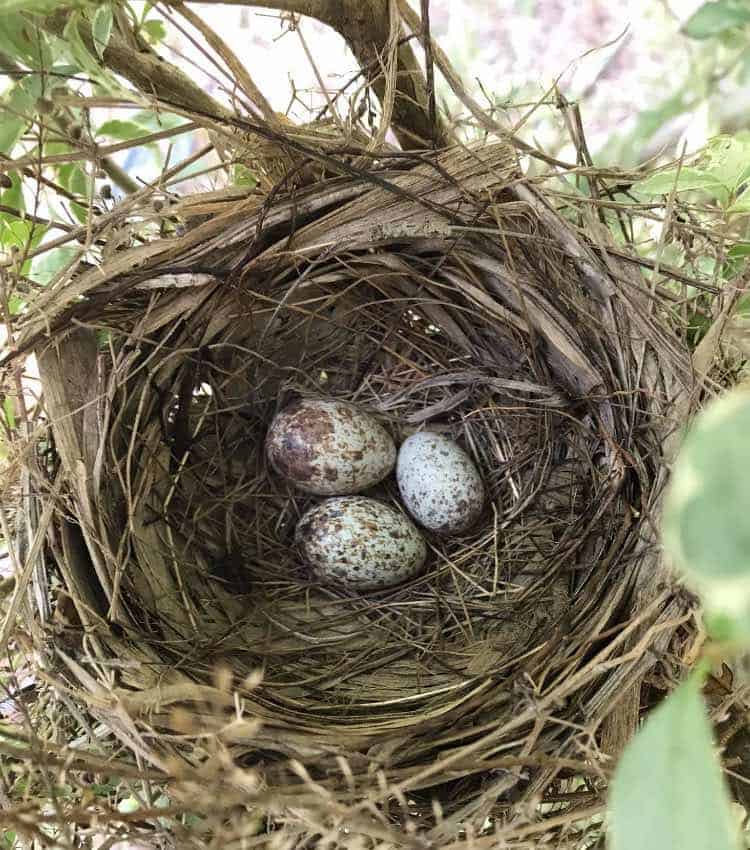
Mother nature gives the dubious privilege of laying eggs to the females in the wild bird kingdom. Female cardinals are no different.
With up to 4 broods per season and up to 5 eggs per brood, the female cardinal might lay more than 20 eggs in a season. And that doesn’t even include eggs that are not viable or unfertilized so don’t hatch.
In the event a nest is lost, such as a predator raids it, the female cardinal scouts for the next nest site nearly immediately. She then builds the nest and starts the egg-laying all over again. Exhausting!
Would You Like More Cardinals to Visit Your Yard?

You can start by making sure your yard is inviting and friendly for cardinals. Download my FREE guide & checklist How to Create a Cardinal-Friendly Yard and you’ll have families of cardinals coming to visit year-round.
Reason #5: The Female Cardinal Incubates the eggs
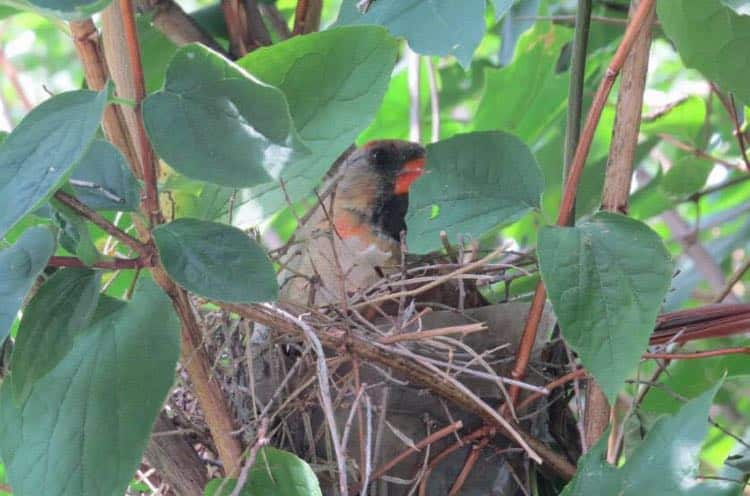
The female is naturally equipped with a brood patch – a bare area of loose skin that covers much of her belly and part of her breast.
The brood patch develops as a result of certain hormones produced during the breeding season and is intended to warm the eggs during incubation and continue to warm the nestlings after they’ve hatched.
Thanks again to Mother Nature, only the female has this crucial part of the body necessary to bring life into the world so only she can perform the incubation task.
The female cardinal remains busy incubating the eggs for about 12-13 days for each brood. Each day she typically incubates for about 35-40 minutes at a time. In between, she takes breaks of a mere 5 – 15 minutes. She must hold still with wings close to the body and tail elevated while constantly on high alert, scanning the area for predators.
Reason #6: The Female Cardinal Broods the Nestlings

Since nestlings don’t start producing their own heat until after 4-5 days, momma cardinal continues to warm them using the brood patch.
Reason #7: The Female Cardinal is the Primary diaper changer
Since the nest isn’t equipped with an outhouse. Instead, it’s the parent’s responsibility to keep the nest clean and that means either eating or removing the fecal sacs (poop).
During the nestlings’ first 4-5 days of life, both parents pitch in and eat the fecal sacs. After that, it’s primarily the female that carries the fecal sacs out of the nest and disposes of them.
If you consider nestlings are being fed constantly and produce a fecal sac after every 3-4 feedings, the female cardinal is kept plenty busy with the business of diaper changing.
Reason #8: The Female Cardinal is Adopter of other birds’ chicks
Brown-headed Cowbirds are “brood parasites” which means the female does not raise her young. Instead, she drops her eggs in other species’ nests for them to raise.
It’s fairly common for brown-headed cowbirds to use a cardinal’s nest for this purpose. Although it’s not her offspring, the female cardinal will incubate and raise up the chick as her own. As if the female cardinal doesn’t have enough to do – now she’s adopting other birds’ babies.
Reason #9: The Female Cardinal Takes care of the young
Taking care of the young cardinal babies doesn’t end with incubation, brooding of the nestlings, and diaper changes.
The young still need to be cared for in other ways including non-stop feedings, preparing them to fledge, teaching them to fly, and forage for food on their own.
The male cardinal helps out with a lot of these activities but the female is also still very active.
Female Cardinals Outside of the Breeding Season
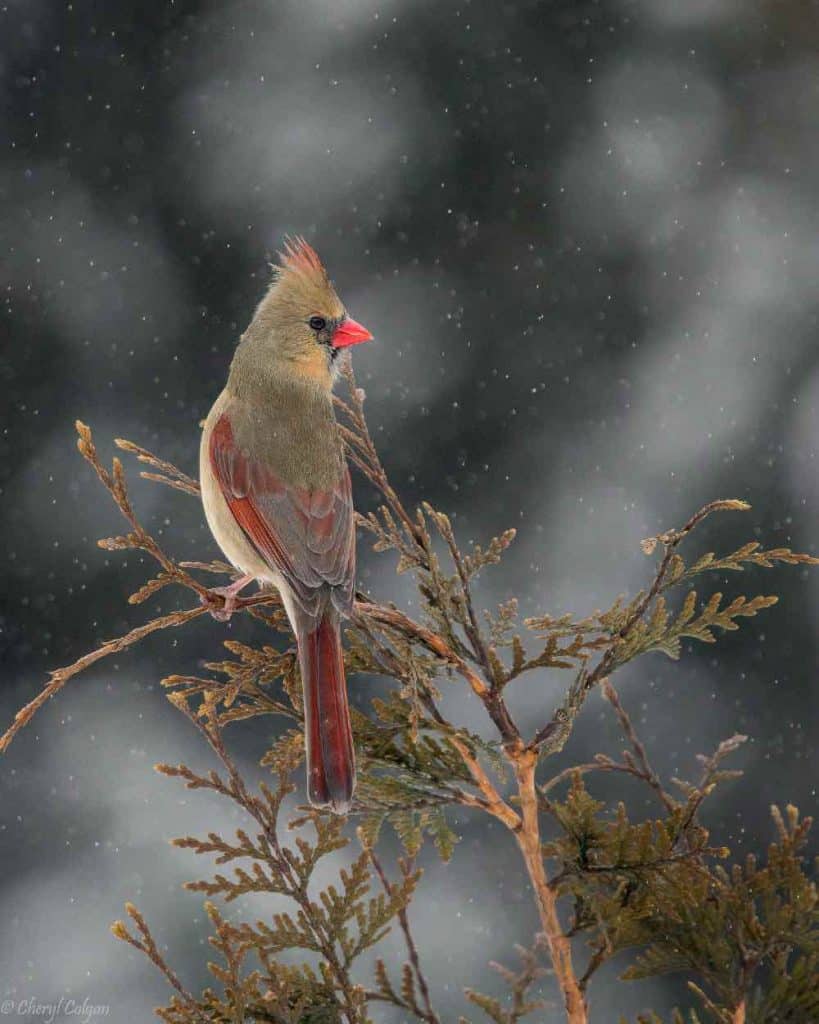
In early fall, the last brood is ready to be independent of mom and dad cardinal. Although the juveniles will stay in the territory with one or both parents through winter, they are able to take care of themselves.
Finally, the female cardinal has no dependents and no jobs she must do to support the reproduction of her species! Now, she can redirect her focus to winter survival.
During late fall and winter, the female cardinal will join large flocks and range within or near the territory in which she and her mate spent the breeding season. Together they’ll forage for food & water and seek shelter from the elements.
When January and February roll around, she’ll pair back up with the mate from last year, or find a new mate, and start the breeding ritual. All. Over. Again.
The Female Cardinal Sounds
Female Cardinal Call
Female Cardinal Song
Enjoy this lovely video of the female cardinal singing & calling!
Final Thoughts
I don’t know about you, but my hat goes off to the female cardinal. She truly deserves to be Mother of the Year! For more than 6 straight months she tirelessly devotes all of her time and energy to her family. Sure, the male helps out in a lot of ways, but without her who knows where the cardinal species would be today?
Sources
Ritchison, G. 1997. Wild Bird Guides: Northern Cardinal. Stackpole Books, Mechanicsburg, PA

